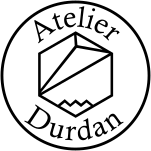
This week, I'd like to share with you the recent developments made to our leather cases. Far from being mere cosmetic adjustments, these changes reflect our philosophy of constant improvement and my commitment to deepening traditional leathercraft techniques.
From engraving to hot stamping
The first development concerns the marking of our logo on the snap fastener. Previously, we machined these small metal parts directly on our machining center. While the result was satisfactory, this method had several drawbacks:
- Random repeatability due to dimensional variations of the buttons
- A structural weakening of the buttons, which are already relatively thin
- Technical complexity disproportionate to the desired result
So we developed a bronze die in-house for hot stamping. This development was not without challenges: the first version produced asymmetrical impressions, requiring me to rework the machine to obtain a perfectly balanced die.
The result is a bright, crisp, and durable print that doesn't compromise the button's integrity. For future runs, the imprint will be in silver to match our existing color schemes.
The return to traditional gestures
The second major development concerns the cutting and punching of cases. After several months of use, I decided to abandon automated methods and return to entirely manual work.
This choice is not motivated by a simple search for authenticity, but by very pragmatic considerations:
- Elimination of leather peeling problems during machine cutting
- Resolving material lifts during automated punching
- Simplification of the process for unit productions
- Superior finish quality, each cut carefully checked
So I developed specific templates and refined my manual cutting and punching techniques, allowing consistent precision without the technical constraints of automated methods.
An immersion in the art of leather goods
This development is part of a broader approach to deepening leatherworking techniques. Beyond improving our existing products, it also explores new possibilities for future creations.
The skills acquired in developing precise templates and manual punching techniques open the door to more ambitious projects that I look forward to sharing with you in the coming months.
A project under consideration: the ideal toiletry bag
Among these projects is a toiletry bag specially designed for traditional shaving enthusiasts. I envision an accessory incorporating dedicated spaces for each essential element of your ritual.
And this is where I'd like to ask you : what do you think the ideal shaving kit would be? Which compartments would be essential? What size would you prefer? Would you prefer a compact size for travel or a more generous one for everyday use?
Your feedback will be valuable in shaping this future project according to your real needs.
In conclusion
These subtle developments in leather cases illustrate our ongoing commitment to craftsmanship excellence. The price remains unchanged, true to our philosophy of perfecting our designs without impacting our customers.
I will be sharing photos detailing these manufacturing processes very soon - from hand cutting to sewing, to the finished products.
Please feel free to share your thoughts on these developments or suggestions for the future shaving kit in the comments.
Augustine 




